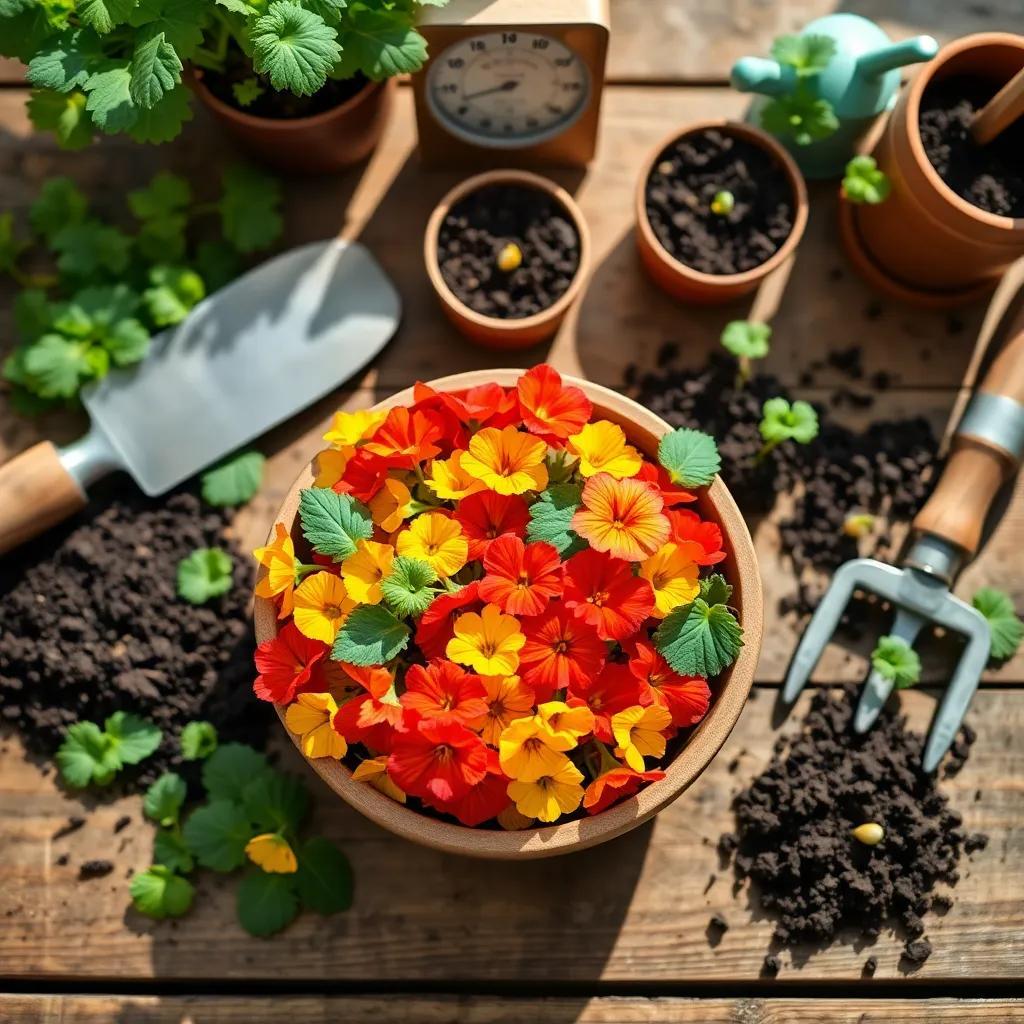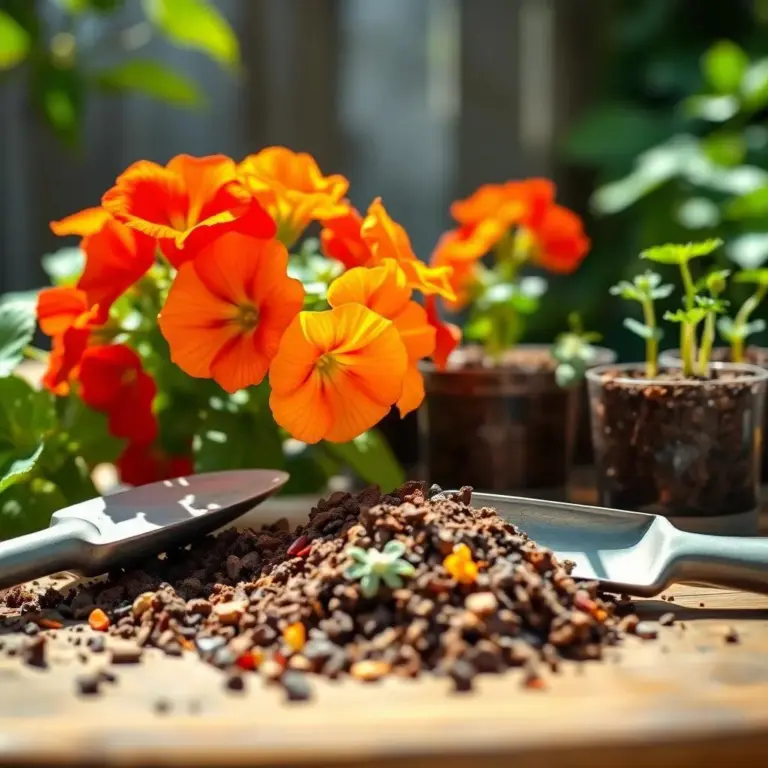Have you ever wondered how long it takes for those colorful Nasturtium seeds to transform into beautiful flowers? Growing these vibrant plants can be so much fun, but getting them to germinate just right can feel like a bit of a puzzle! Join me as we explore the secrets to successful germination, and let’s get your garden blooming in no time!
Factors That Influence Nasturtium Seed Germination Time
When I start planting my Nasturtium seeds, I often wonder what makes some germinate faster than others. It’s like waiting for a surprise party to begin—everyone’s excited, but it depends on a few key factors! Let’s break down what influences how quickly those little seeds will pop up and show off their vibrant colors.
- Seed Quality: Have you ever tried planting some old seeds and been a bit disappointed? Fresh seeds are like fresh ingredients in a recipe—they work better! So, always pick up some quality seeds if you want good germination rates. Trust me, it’s worth it!
- Temperature: Nasturtiums are party animals when it comes to warmth! They thrive in a cozy range of 65°F to 75°F (18°C to 24°C). If it gets cooler, they might just decide to take a nap instead of sprouting. So make sure to keep them warm!
- Moisture: This is another biggie! Nasturtium seeds love a moist environment, but not too moist! Think of it like a well-balanced smoothie—just right! Too much water can lead to rot, while too little can leave them parched. It’s all about balance!
- Light: Interestingly, these seeds don’t need sun to germinate! So, plant them about an inch deep and let them do their thing in the dark for a bit. But once they sprout, make sure they get 6-8 hours of sunlight a day. They’ll thank you for it later!
Remember, nurturing your Nasturtium seeds is all about giving them the right conditions. Keep these factors in mind, and you’ll be well on your way to a blooming garden in no time!
Ideal Growing Conditions for Faster Germination
Creating the perfect environment for your Nasturtium seeds is like setting the stage for a fantastic show. It’s all about those ideal conditions! Here’s how to create a home sweet home for your little green friends, ensuring they sprout quickly and happily.
- Soil: Start with well-draining soil rich in organic matter. You can mix in some compost to give it a nutrient boost. A pH level between 6.0 and 7.5 is best. Use a garden fork to fluff it up a bit; think of it as giving your soil a nice massage!
- Planting Depth: Just like goldilocks, Nasturtium seeds need the depth just right. Plant them about 1 inch deep. Too shallow and they might dry out; too deep and they’ll struggle to break through. It’s all about finding that sweet spot!
- Temperature: Warm, but not too hot! Keep that cozy range of 65°F to 75°F (18°C to 24°C). You can use heating mats or simply place your pots in a warm area of your home. They’ll be loving the heat!
- Moisture: After planting, water them gently but good. Think of a light mist rather than a heavy rain! Maintain consistent moisture, but don’t drown them. Nobody likes soggy soil!
- Light: Initially, your seeds don’t need light, but once they sprout, give them plenty of sunshine! Place them where they can soak up 6-8 hours daily. They’ll bloom with all the energy and vibrancy!
These ideal conditions will help your Nasturtiums flourish beautifully. So let’s get those seeds planted and enjoy the show that follows!

Average Germination Time for Nasturtium Seeds
So, you’ve planted your Nasturtium seeds, and now you’re sitting there, eagerly waiting for them to sprout! It’s like waiting for popcorn to pop—so exciting! On average, Nasturtium seeds take about 7 to 14 days to germinate. But don’t be surprised if some take a little longer. Sometimes, nature has its own timeline!
Here are some things to keep in mind regarding germination time:
- Factors: As we talked about earlier, different factors like temperature, moisture, and seed quality play a big role in how quickly your seeds will sprout. If conditions are perfect, you might see tiny seedlings in just 7 days! How great is that?
- Patience is Key: If you don’t see any action after about two weeks, don’t panic! It could still happen. Sometimes, they might take up to 21 days or even longer if they’re feeling a bit lazy. Just keep the faith, and give them the time they need.
- Observe Growth Stages: Once those seeds start to sprout, you’ll see some cool stages of growth. First, a little root pops out, and then the cotyledons (the first leaves) appear. These leaves will help feed the baby plant until it can make its own food.
So, while you’re waiting, maybe grab a cozy blanket, a cup of tea, and keep an eye out for those tiny green miracles. Your patience will surely pay off!
Tips to Accelerate the Germination Process
Are you just as excited as I am to see those Nasturtiums sprout? If you’re looking for ways to speed things up, I’ve got a few handy tips for you! Think of these tips as your secret gardening hacks. Here’s how to get those seeds to germinate faster:
- Pre-soak the Seeds: Soaking your seeds for 12 to 24 hours in water before planting can really help. This softens the hard seed coat and gets them ready to sprout—just like softening butter before baking!
- Scarification: Giving your seeds a little scratch can work wonders! Use a nail file or some fine sandpaper to gently scarify the seed coat. This allows moisture to penetrate better and speeds up those germination juices.
- Bottom Heat: If you want to give your seeds a warm hug, place them on a heating mat or a warm surface. Keeping them warm helps kickstart the germination process. It’s like giving them a cozy bed to sleep in!
- Consistent Moisture: Keep the soil consistently moist—not soggy! Regularly check in on your seeds and water them gently to keep the moisture just right.
- Indoor Germination: Starting your seeds indoors gives you more control over conditions. Use seed trays with high-quality soil, and place them in a sunny spot or under grow lights. You’ll be amazed at how quickly they can sprout!
With these tips in your gardening toolkit, you’ll be well on your way to seeing those lovely Nasturtiums pop up like magic! Happy planting!
Common Problems and Solutions During Germination
While I love growing my Nasturtiums, there can be a few hiccups along the way. But don’t worry! Most of these common problems are easy to fix. Let’s explore some of the most frequent issues you might run into while waiting for those seedlings, along with simple solutions to help you out!
- Poor Seed Quality: If your seeds are old or have been stored improperly, they might not germinate at all. If germination rates are low, it’s time to check the freshness of your seeds. Trust your source—fresh seeds from a reputable store will likely give you better results!
- Inadequate Moisture: Too little moisture can halt germination. If the soil is dry, the seeds won’t absorb enough water. Make sure to keep the soil damp, but again, avoid creating a swamp! A light touch with your watering can should do.
- Temperature Fluctuations: Nasturtiums like a cozy climate. If it gets too hot or too cold, they may decide to take a break! Aim for that sweet spot of 65°F to 75°F (18°C to 24°C) and keep an eye on the thermometer.
- Pest and Disease Issues: Sometimes, pests want to join the party. Inspect your soil and seedlings regularly for any signs of trouble. A little organic pest control can go a long way!
- Seed Dormancy: Some seeds just don’t want to wake up! If you suspect dormancy is the issue, try pre-soaking or scarifying your seeds to help them along.
- Improper Planting Depth: Planting too shallow or too deep can confuse your seeds. Aim for that 1-inch depth to keep them cozy underground.
Addressing these common problems can help you stay on track and boost your chances of successful germination. Gardening is all about learning—and I just know you’ll become a pro in no time! Happy gardening!

